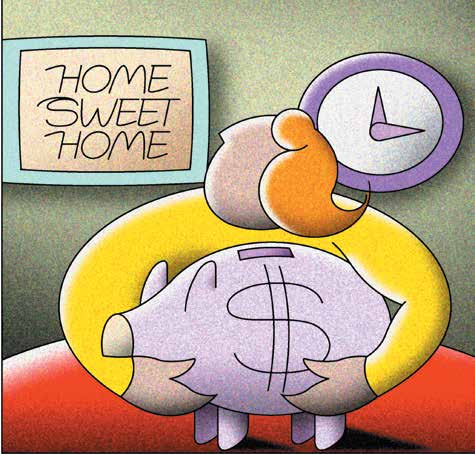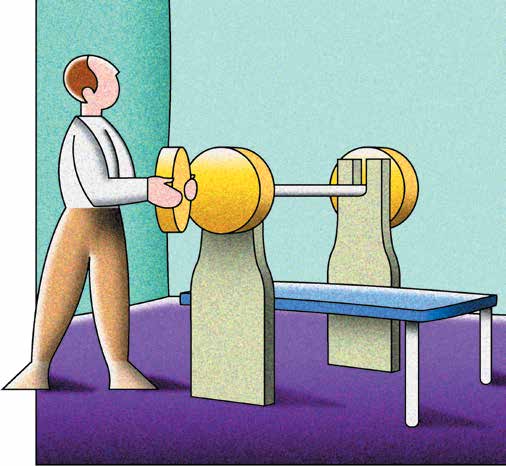Saving For Retirement
Keep only one or two cards, not the usual eight or
Once you’ve reduced unnecessary debt and created
nine.
a workable spending plan that frees up money, you’re
Don’t charge big-ticket items. Find less expensive
ready to begin saving toward retirement. You may do
loan alternatives.
this through a company retirement plan or on your own
Shop around for the best interest rates, annual fees, — options that are covered in more detail later in this service fees, and grace periods.
booklet. First, however, let’s look at a few of the places
Pay off the card each month, or at least pay more
where you might put your money for retirement.
than the minimum.
Savings accounts, money market mutual funds,
Still have problems? Leave the cards at home or cut certificates of deposit, and U.S. Treasury bills.
them up.
These are sometimes referred to as cash or cash
How to climb out of debt. Despite your best efforts, you equivalents because you can get to them quickly
may find yourself in severe debt. Worksheet 6–Debt
and there’s little risk of losing the money you put in.
Reduction in the back of this booklet can help you come Domestic bonds. You loan money to a U.S.
up with a plan to pay down your credit card and other
company or a government body in return for its
bad debt. A credit counseling service can help you set
promise to pay back what you loaned, with interest.
up a plan to work with your creditors and reduce your
Domestic stocks. You own part of a U.S. company.
U.S. Department of Labor Employee Benefits Security Administration 13
SAVINGS FITNESS A GUIDE TO YOUR MONEY AND YOUR FINANCIAL FUTURE
Mutual funds. Instead of investing directly in
Choosing where to put your money. How do you decide
stocks, bonds, or real estate, for example, you can where to put your money? Look back at the short-term use mutual funds. These pool your money with
goals you wrote down earlier — a family vacation,
money of other shareholders and invest it for you. perhaps, or the down payment for a home. Remember, A stock mutual fund, for example, would invest
you should always be saving for retirement. But, for
in stocks on behalf of all the fund’s shareholders.
goals you want to happen soon — say, within a year —
This makes it easier to invest and to diversify your it’s best to put your money into one or more of the cash money.
equivalents — a bank account or CD, for example. You’ll
earn a little interest and the money will be there when
you need it.
Tips On How To Save Smart For Retirement
• Start now. Don’t wait. Time is critical.
• Start small, if necessary. Money may be tight, but even small amounts can make a big dif fer ence given enough time, the right kind of investments, and tax-favored vehicles such as com pany re tire ment plans and IRAs.
• Use automatic deductions from your payroll or your checking account for de pos it in mu tu al funds, IRAs, or other investment vehicles.
• Save regularly. Make saving for retirement a habit.
• Be realistic about investment returns. Never assume that a year or two of high mar ke t re turns will continue indefinitely. The same goes for market declines.
• If you change jobs, keep your retirement account money in your former employer’s plan or roll it over into your new employer’s plan or an IRA.
• Don’t dip into retirement savings.
For goals that are at least 5 years in the future,
however, such as retirement, you may want to put
some of your money into stocks, bonds, real estate,
foreign investments, mutual funds, or other assets.
Unlike savings accounts or bank CDs, these types of
investments typically are not insured by the federal
government. There is the risk that you can lose some
of your money. How much risk depends on the type of
14

PERSONAL
PFINANCIAL FITNESS
investment. Generally, the longer you have
until retirement and the greater your other
sources of income, the more risk you can
afford. For those who will be retiring soon
and who will depend on their investment
for income during their retirement years, a
low-risk investment strategy is more prudent.
Only you can decide how much risk to take.
Why take any risk at all? Because
the greater the risk, the greater the potential
reward. By investing carefully in such things
as stocks and bonds, you are likely to earn
significantly more money than by keeping
all of your retirement money in a savings
account, for example.
The differences in the average
annual returns of various types of
investments over time is dramatic. Over the
last 50 years, the compound annual rate
of return of short-term U.S. Treasury bills,
which roughly equals the return of other
Many financial experts feel it is important to
cash equivalents such as savings accounts, has been
save at least a portion of your retirement money in higher
5.2 percent. The compound annual rate of return of
risk — but potentially higher returning — assets. These
long-term government bonds over the same period has
higher risk assets can help you stay ahead of inflation,
been 7.1 percent. Large-company stocks, on the other
which eats away at your nest egg over time.
hand, while riskier have averaged an annual return of 9.8
Which assets you want to invest in, of course,
percent.
is your decision. Never invest in anything you don’t
Let’s put that into dollars. If you had invested
thoroughly understand or don’t feel comfortable about.
$1 in Treasury bills 50 years ago, it would have grown to
approximately $13 today. However, inflation, at an annual
average of 4.1 percent, would have eaten about $11 of
that gain leaving $1.75 as the return. If the $1 had been
invested in government bonds, it would have grown to
$31, with $4.16 left after inflation. If the $1 had been
invested in large-company stocks, it would have grown to
$105, with $14.22 left after inflation. None of these rates of returns is guaranteed in the future, but they clearly show
the relationship between risk and potential reward.
U.S. Department of Labor Employee Benefits Security Administration 15
SAVINGS FITNESS A GUIDE TO YOUR MONEY AND YOUR FINANCIAL FUTURE
Reducing investment risk. There are two main ways
Deciding on an investment mix. How you diversify —
to reduce risk. First, diversify within each category that is, how much you decide to put into each type of
of investment. You can do this by investing in pooled
investment — is called asset allocation. For example,
arrangements, such as mutual funds, index funds, and if you decide to invest in stocks, how much of your bank products offered by reliable professionals. These
retirement nest egg should you put into stocks:
investments typically give you a small share of different 10 percent … 30 percent … 75 percent? How individual investments and will allow you to spread
much into bonds and cash? Your decision will depend
your money among many stocks, bonds, and other
on many factors: how much time you have until
financial instruments, even if you don’t have a lot of
retirement, your life expectancy, the size of your
money to invest. Your risk of losing money is less than
current nest egg, other sources of retirement income,
if you buy shares in only a few individual companies.
how much risk you are willing to take, and how healthy
Distributing your investments in this way is called
your current financial picture is, among others.
diversification.
Your asset allocation also may change over
Second, you can reduce risk by investing
time. When you are younger, you might invest more
among categories of investments. Generally speaking, heavily in stocks than bonds and cash. As you get older you should put some of your money in cash, some in
and enter retirement, you may reduce your exposure
bonds, some in stocks, and some in other investment
to stocks and hold more in bonds and cash. You also
vehicles. Studies have shown that once you have
might change your asset allocation because your
diversified your investments within each category, the
goals, risk tolerance, or financial circumstances have
choices you make about how much to put in these
changed.
major categories is the most important decision you
Rebalancing your portfolio. Once you’ve decided on
will make and should define your investment strategy.
your investment mix and invested your money, over
Why diversify? Because at any given time one
time some of your investments will go up and others
investment or type of investment might do better than will go down. If this continues, you may eventually another. Diversification lets you manage your risk in a
have a different investment mix than you intended.
particular investment or category of investments and
Reassessing your mix, or rebalancing, as it is commonly
decreases your chances of losing money. In fact, the
called, brings your portfolio back to your original
factors that can cause one investment to do poorly may plan. Rebalancing also helps you to make logical, not cause another to do well. Bond prices, for example,
emotional, investment decisions.
often go down when stock prices are up. When stock
For instance, instead of selling investments in
prices go down, bonds often increase in value. Over a
a sector that is declining, you would sell an investment
long time — the time you probably have to save for
that has made gains and, with that money, purchase
retirement — the risk of losing money or earning less
more in the declining investment sector. This way, you
than you would in a savings account tends to decline.
rebalance your portfolio mix, lessen your risk of loss,
By diversifying into different types of assets,
and increase your chance for greater returns in the
you are more likely to reduce risk, and actually
long run.
improve return, than by putting all of your money into
Here’s how rebalancing works: Let’s say your
one investment or one type of investment. The familiar original investment called for 10 percent in U. S. small adage “Don’t put all your eggs in one basket” definitely
company stocks. Because of a stock market decline,
applies to investing.
they now represent 6 percent of your portfolio. You
16

MAXIMIZING YOUR





